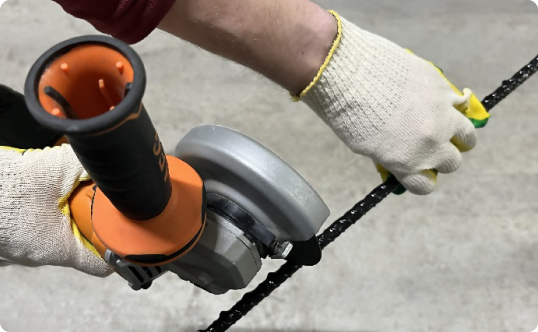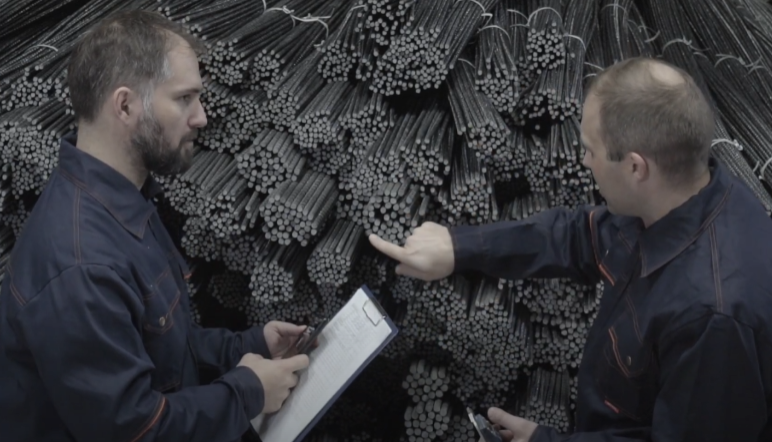Advantages
Fiberglass reinforcement and Templet mesh are modern materials that successfully replace traditional metal counterparts in construction and repair. Their popularity is growing due to their unique properties, providing reliability, durability, and economic benefits.
Key Advantages
1. High Strength Composite reinforcement and mesh provide more than twice the tensile strength compared to metal reinforcement of the same diameter.
2. Lightweight
The weight of 1 meter of fiberglass reinforcement is 4 times lighter than 1 meter of steel reinforcement of the same diameter.
With equivalent strength replacement, this allows for a 7-9 times reduction in the weight of reinforcement.
3. Corrosion Resistance
Unaffected by water, salt, and humidity, making it ideal for aggressive environments.
The lifespan exceeds 100 years, ensuring the durability of structures.
4. Ease of Use and Safety Fiberglass reinforcement and mesh are easy to cut with hand tools, produce no sparks, and eliminate the risk of fire.
5. Flexibility and Resistance to Deformation Unlike their metal counterparts, composite reinforcing products (reinforcement bars and mesh) do not develop plastic deformations and retain their shape even after being subjected to heavy machinery. This significantly simplifies the process of reinforcement and pouring for horizontal surfaces, allowing equipment to maneuver easily on the construction site.
Composite reinforcement bars and mesh are not susceptible to plastic deformation and do not have shape memory. Thanks to these unique properties, they can be stored and transported in the form of round coils and rolls of significant length. This greatly accelerates the reinforcement installation process on-site and saves storage space.
6. Eco-Friendliness (Made from Recycled Glass)
Composite materials do not create "thermal bridges," enhancing insulation and reducing the energy consumption of buildings.
Their production requires 9 times less electricity than steel counterparts, significantly reducing the carbon footprint.
7. Safety in Challenging Conditions It does not conduct electricity and does not create magnetic fields, making it safe for use in buildings with high electromagnetic safety requirements, such as medical facilities and laboratories.
8. Perfect Compatibility with Concrete The coefficient of thermal expansion of fiberglass reinforcement is equal to that of concrete. Therefore, temperature fluctuations in structures do not create thermal stresses, and they last longer. The manufacturing technology of composite reinforcement allows for variation in the parameters of the periodic profile, exceeding the bonding strength with concrete compared to metal reinforcement. Due to its unique elastic properties, the composite material does not cause issues during the shrinkage of high-strength concrete classes.
One of the problems with layered composite materials is the transfer of shear force between the layers. This is why the inner fibers of reinforcement (especially large-diameter reinforcement) are not as actively involved in the load-bearing work – the load from the outer layers is not properly transferred to the inner ones, and while the outer fibers are already stretched to their limit, the inner ones work at only 50-90% of their potential. The exact value depends on the diameter and length of the reinforcement. To improve the efficiency of reinforcement, we additionally pre-tension the inner fibers and increase its stiffness and strength.
The use of fiberglass reinforcement and mesh is not only a technological solution but also a way to reduce costs, increase reliability, and extend the service life of construction projects. These are materials of the future that already make construction simpler, safer, and more efficient.
| Parameter | Fiberglass rebar | Steel rebar

|
||||||
| Type of rebar | Rebar from “Templet LLP”

|
World standards

|
A240 | A300 | A400 | A500 | A600 | A800 |
| Tensile strength, MPa | Up to 1367 | ~ 500 - 1000 | 240 | 300 | 400 | 500 | 600 | 800 |
| Nominal diameter, mm | ||||||||
| 6 | 7 | 11 | 10 | 9 | 8 | 8 | 7 | |
| 8 | 9 | 15 | 14 | 12 | 10 | 10 | 9 | |
| 10 | 11 | 20 | 18 | 16 | 13 | 12 | 11 | |
| 13 | 14 | 25 | 22 | 19 | 17 | 16 | 13 | |
| 14 | 15 | 27 | 24 | 21 | 19 | 17 | 15 | |
| 16 | 17 | 30 | 27 | 23 | 21 | 19 | 17 | |
9. The sagging bending of fiberglass and steel reinforcement is similar Under equal load conditions and span length, the sagging of fiberglass and steel reinforcement will be the same. This means that fiberglass reinforcement, despite its lightness and high corrosion resistance, has similar rigidity and deformation characteristics compared to traditional steel reinforcement.
2% of the total time takes to pour down the concrete, the rest is preparation Pouring concrete takes only 2% of the total time in the concreting process, while the remaining 98% is spent on preparatory stages, including the installation of reinforcement frames and formwork. These stages play a crucial role in ensuring the strength and durability of the structure.
FAQ
© 2026 Templet. All Rights Reserved








